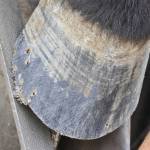Drug May Be Laminitis Breakthrough

Despite decades of research, laminitis remains a leading cause of death in horses. Many equines are humanely destroyed each year because their intense pain and crippling inflammation can’t be alleviated by treatments including medication, therapeutic shoeing, cryotherapy, and other management tools.
An anti-inflammatory drug discovered 40 years ago, but never used on large animals, may be the breakthrough that veterinarians and horse owners have been looking for.
The first horse to benefit was a laminitic mare being treated at the University of California Davis School of Veterinary Medicine. Although she had been intensively treated with conventional methods, the mare was not responding well. As her condition worsened to the point that euthanasia seemed to be the only recourse, veterinarians decided to try an experimental anti-inflammatory drug called t-TUCB on the mare. The drug had been discovered by scientists doing research on biological insect control and had not been used in horses, though it had been effective in relieving pain and inflammation in mice and rats.
After the first day of treatment, the mare’s condition improved dramatically. Continued use of t-TUCB allowed the mare to return to a pain-free state with normal blood pressure and acceptable posture and mobility. A report of the case is to be published in Journal of Veterinary Anaesthesia and Analgesia.








